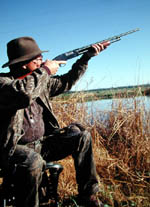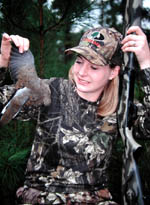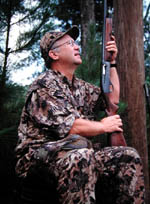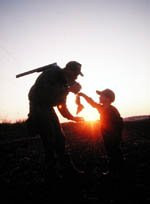
|
Features
|
|
|
|
Books
|
|
|
|
Fun & Games
|
|
|
|
Contact Us
|
|
|
John's Journal... Entry 211, Day 3
SECRETS TO TAKING MORE DOVES WITH TONY ROSETTI
More Dove-Hunting Secrets
 EDITOR'S
NOTE: Tony Rosetti not only has the reputation
in years past as one of the nation's best shots but also has proved his
prowess with a shotgun in national and international competitions. He
was the United States International World Champion in1969, 1971 and 1972;
the National Skeet-Shooting World Champion, an aggregate of all four gauges
.410, .28, and .12, in 1970 and 1972; the World Champion in 1972 in .12
gauge and .410 gauge; the last person to win three of the five World Gauge
Championships; a member of the Pan-American Games Gold Medal Team in 1971;
the Silver medal individual winner in 1971; a member of the 1972 U.S.
Olympic Shooting Team;, and the past winner of the Mississippi State Championship
and many other championships and big-gun shoots.
EDITOR'S
NOTE: Tony Rosetti not only has the reputation
in years past as one of the nation's best shots but also has proved his
prowess with a shotgun in national and international competitions. He
was the United States International World Champion in1969, 1971 and 1972;
the National Skeet-Shooting World Champion, an aggregate of all four gauges
.410, .28, and .12, in 1970 and 1972; the World Champion in 1972 in .12
gauge and .410 gauge; the last person to win three of the five World Gauge
Championships; a member of the Pan-American Games Gold Medal Team in 1971;
the Silver medal individual winner in 1971; a member of the 1972 U.S.
Olympic Shooting Team;, and the past winner of the Mississippi State Championship
and many other championships and big-gun shoots.
Learn Why You're Missing: According to Rosetti, "A good wing-shooting instructor will be able to tell you whether you're shooting in front of or behind the targets and teach you the proper shooting position to correct your misses. He'll look at the way you mount the gun and watch the position of your head when you shoot. He'll notice if you pick your head up off the stock, which can cause you to miss. If you raise your head up even only 1/2-inch above the rib, you'll shoot 3-feet high. Usually you won't be able to tell whether you're raising your head up or not. All you need to see when you shoot correctly is the bead of the shotgun and the bird. Taking a lesson or two from a shooting instructor will allow you to identify your mistakes and shoot more accurately."
 Understand
When To Shoot: As Rosetti mentions, "Don't hesitate too long to shoot.
Often a hunter waits until a dove is right on top of him before taking
the shot. But the best place to try and bag a dove is when it's out in
front of you. Probably the most-difficult shot is attempting to take a
dove when it's straight up over your head. Instead, try and bag doves
somewhat further away. Get into the proper shooting position before you
squeeze the trigger. Then if the bird does start to dip to the left or
the right, you may have time to compensate for the dove's movement, if
it's further out in front of you instead of straight up over your head.
Remember, doves don't fly like clay targets. When they're riding the wind,
zigging and zagging, you need to have enough time to compensate for their
erratic flight before you squeeze the trigger. You won't have time to
make those adjustments if you let the bird get too close. If I see a dove
darting as it comes into the field, I plan to bag that dove when it's
20- to 30-yards out. Then my shot pattern can open out. Even if the bird
does dart to the left or the right, there will be enough shot in the air
to down it. When a dove is closer to you, your shot pattern is tighter,
and the dove has a better chance of dodging the shot."
Understand
When To Shoot: As Rosetti mentions, "Don't hesitate too long to shoot.
Often a hunter waits until a dove is right on top of him before taking
the shot. But the best place to try and bag a dove is when it's out in
front of you. Probably the most-difficult shot is attempting to take a
dove when it's straight up over your head. Instead, try and bag doves
somewhat further away. Get into the proper shooting position before you
squeeze the trigger. Then if the bird does start to dip to the left or
the right, you may have time to compensate for the dove's movement, if
it's further out in front of you instead of straight up over your head.
Remember, doves don't fly like clay targets. When they're riding the wind,
zigging and zagging, you need to have enough time to compensate for their
erratic flight before you squeeze the trigger. You won't have time to
make those adjustments if you let the bird get too close. If I see a dove
darting as it comes into the field, I plan to bag that dove when it's
20- to 30-yards out. Then my shot pattern can open out. Even if the bird
does dart to the left or the right, there will be enough shot in the air
to down it. When a dove is closer to you, your shot pattern is tighter,
and the dove has a better chance of dodging the shot."
 Know
How To Take A follow-Up Shot: After you have shot and missed a dove, Rosetti
suggests you forget about the first shot. "Concentrate on the second shot.
Make sure your cheek is still against the stock. Remember to swing your
barrel out in front of the bird before you squeeze the trigger. Most of
the time the second shot will be the most difficult to make. Since the
bird is generally closer to you then when you made your first shot, you'll
tend to rush the second shot."
Know
How To Take A follow-Up Shot: After you have shot and missed a dove, Rosetti
suggests you forget about the first shot. "Concentrate on the second shot.
Make sure your cheek is still against the stock. Remember to swing your
barrel out in front of the bird before you squeeze the trigger. Most of
the time the second shot will be the most difficult to make. Since the
bird is generally closer to you then when you made your first shot, you'll
tend to rush the second shot."
Determine Lead: Most shooters kill their doves within 25 to 30 yards of the shooter. Rosetti comments that, "Determining your lead depends on how strong the wind blows, how fast the dove flies, if the birds are flying with or against the wind, and what distance you are from the dove. Generally, if you attempt to bag doves from 25 to 30 yards, then lead the bird 3 to 4 feet. To learn to use a 4-foot lead, put two sticks on the ground 4-feet apart. Aim at the first stick while looking at the second stick. This exercise will help you determine what a 4-foot lead looks like. If you aren't able to judge a 4-foot lead on the ground, you'll have a difficult time determining what a 4-foot lead is in the air."
 Use
The Chokes And Shells Best For Dove Hunting: Most people tend to overchoke
themselves when hunting doves. They either use modified or full chokes
believing that with tighter chokes they can bag doves at greater distances
-- perhaps out to 50 or 60 yards. However, for every bird they bag at
50 to 60 yards, they'll miss five or six birds out of 10 that will be
at 25 yards or less. Rosetti has found that the best all-around choke
for the dove hunter is, "The modified. I prefer 3 drams of powder with
the equivalent of 1-1/8-ounces of No. 8 shot for shooting doves. I use
the super-light trap loads instead of the economy shells or promotional
shells most dove hunters tend to shoot. By paying $1.50 more per box for
high-quality trap loads that have been formulated to produce the most
dense pattern at the greater distances, I bag more doves than the hunters
do who shoot the less expensive shells."
Use
The Chokes And Shells Best For Dove Hunting: Most people tend to overchoke
themselves when hunting doves. They either use modified or full chokes
believing that with tighter chokes they can bag doves at greater distances
-- perhaps out to 50 or 60 yards. However, for every bird they bag at
50 to 60 yards, they'll miss five or six birds out of 10 that will be
at 25 yards or less. Rosetti has found that the best all-around choke
for the dove hunter is, "The modified. I prefer 3 drams of powder with
the equivalent of 1-1/8-ounces of No. 8 shot for shooting doves. I use
the super-light trap loads instead of the economy shells or promotional
shells most dove hunters tend to shoot. By paying $1.50 more per box for
high-quality trap loads that have been formulated to produce the most
dense pattern at the greater distances, I bag more doves than the hunters
do who shoot the less expensive shells."
TOMORROW: MORE SECRETS THAT WILL HELP YOU DOVE HUNT SUCCESSFULLY
Check back each day this week for more about SECRETS TO TAKING MORE DOVES WITH TONY ROSETTI ...
Day 1 - What Rosetti Knew
That I Didn't
Day 2 - Three More Secrets To Taking More
Doves
Day 3 - More Dove-Hunting Secrets
Day 4 - More Secrets That Will Help You Dove
Hunt Successfully
Day 5 - Rosetti's Safety Tips and Equipment
Recommendations